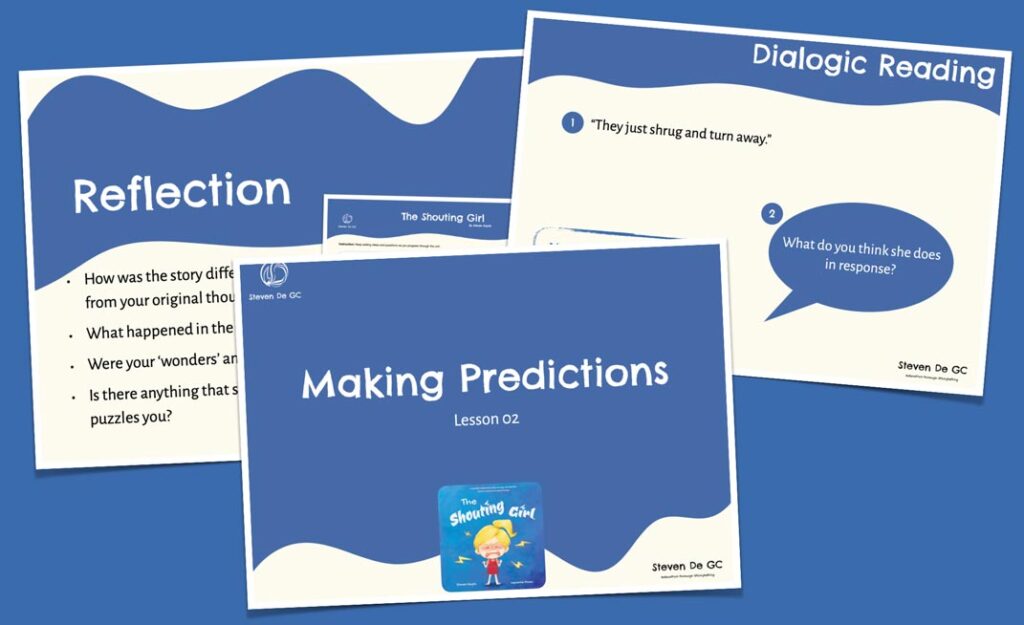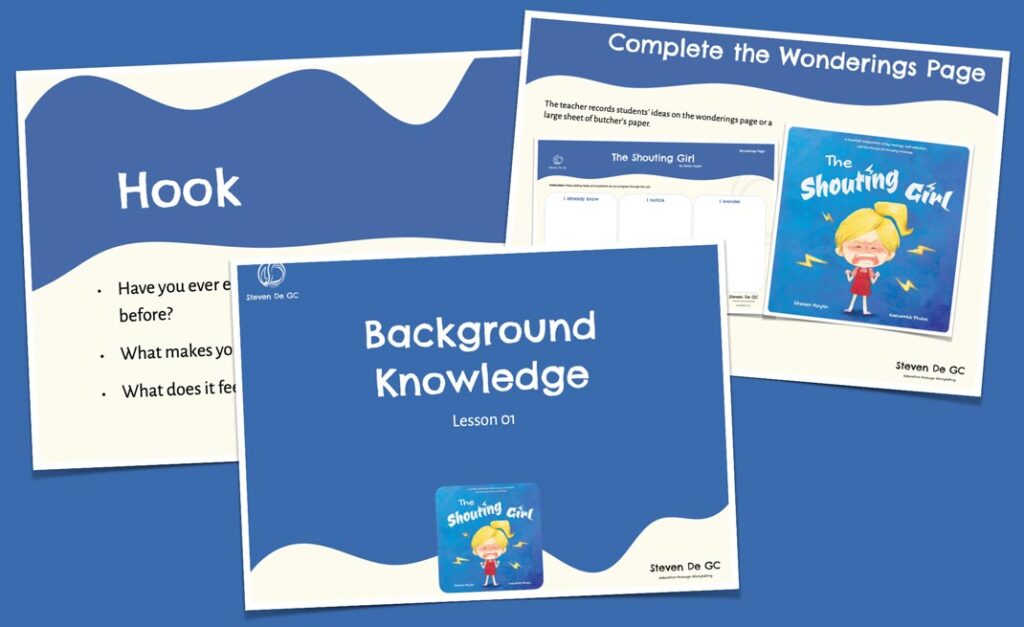- Review
- Who did you meet in the story?
- What surprised you in the story?
- Reading
- Models fluency reading, focussing on expression and intonation.
- Strategic reading: Students actively listen and draw connections to their personal experiences.
- Discussion
- Encourage students to use sentence starters to share their personal preferences and connections to the text.
- Complete the Tell Me chart.
- Wrap-up
- Identify any new vocabulary that helps improve understanding of the text.
[T4R] Stay For Dinner: L3 Book Talk

The Book
Stay For Dinner
Written by Sandhya Parappukkaran, illustrated by Michelle Pereira, published by Bright Light
Stay for Dinner by Sandhya Parappukkaran is a vibrant celebration of cultural diversity and the connections made through shared meals. The story centres on a family preparing a special dinner for their child’s friends, offering a glimpse into various mealtime customs and table manners (AC9HP2P01 – Years 1 and 2, Health and Physical Education). Through the lens of this dinner, the book explores the emotional responses and questions that arise from cultural traditions (AC9HP2P03 – Years 1 and 2, Health and Physical Education), encouraging children to embrace diversity and appreciate the richness of different cultural backgrounds (AC9HP2P02 – Years 1 and 2, Health and Physical Education).
The narrative is brought to life with vivid sound and imagery words such as “squish,” “splash,” “slice,” and “prong,” capturing the sensory experience of the meal. Culinary terms like “papadum,” “sadhya,” and “dumpling” add authenticity and depth, inviting readers into the world of diverse cuisines. As the main character reflects on her and her friends’ mealtime experiences, the story underscores the importance of understanding and respecting different customs, fostering a sense of togetherness and mutual respect.
With its rich illustrations and heartwarming themes, Stay for Dinner inspires children to find joy in sharing meals and traditions, highlighting the value of friendship and cultural appreciation.
Resource creator
Steven Huynh
Subject
Level
Description
This is lesson 3 of the Talk For Reading (T4R) unit Stay For Dinner.
The lesson encourages students form and share initial responses to the text.
Learning Intentions
• We are learning to respond to a text.
Successful Criteria
• I can identify what I like, what I dislike, and personal connections to the text (AC9E2LE02).
• I can use language that appreciates texts (AC9E2LA02).
• I can identify puzzles I have of the text (AC9E2LY05).
Curriculum Alignment
AC9E2LA02 9.0 (English Language and Literacy Year 2): Explore how language can be used for appreciating texts and providing reasons for preferences
• exploring how language is used to appreciate texts using more precise vocabulary; for example, “I liked how the author described the setting because …”
• exploring verbs used to express degree of preference; for example, “liked”, “preferred”, “enjoyed”
• identifying First Nations Australian language words specific to Country/Place that help the reader to be specific when appreciating the setting in a text
AC9E2LE02 9.0 (English Language and Literacy Year 2): Identify features of literary texts, such as characters and settings, and give reasons for personal preferences
• discussing preferences for stories set in familiar or unfamiliar worlds, or about characters whose lives are like or unlike their own
• discussing their feelings about the positive and negative behaviours of non-human characters, such as animals
AC9E2LY05 9.0 (English Language and Literacy Year 2): Use comprehension strategies such as visualising, predicting, connecting, summarising, monitoring and questioning to build literal and inferred meaning
• listening for specific information and providing key facts or points from an informative or persuasive text
• listening and responding to detailed instructions
• integrating information from print, images and prior knowledge to make supportable inferences
• identifying the main idea of a text
• predicting vocabulary that is likely to be in a text, based on the topic and the purpose of the text; for example, predicting that “station” and “arrive” would be in a text recounting a train journey
• using prior knowledge to make and confirm predictions when reading a text
• using graphic organisers to represent the connections between characters, order of events or sequence of information
Materials
- The book Stay For Dinner
- Tell Me chart
- Lesson 3: Book Talk Slides
Instructions
Downloads
| Free Version | Paid Version | |
|---|---|---|
| Material contents | Limited | Full access |
| Instructions | Not included | Included |
| Redownloads | 5 per download | Unlimited |
| Download | FREE DOWNLOAD | BUY WITH |




![[T4R] Stay For Dinner Reading Unit for Year 2 [T4R] Stay For Dinner Reading Unit for Year 2](https://stevendegc.com.au/wp-content/uploads/2025/02/T4R-Stay-For-Dinner-UnitOverviewCover-1024x627.jpg)


![[T4R] Let’s Build a Boat: L11 Evaluation and Reflection [T4R] Let’s Build a Boat: L11 Evaluation and Reflection](https://stevendegc.com.au/wp-content/uploads/2025/05/LetsBuildaBoat-T4R-Lesson11-Cover-1024x626.jpg)
![[T4R] Let’s Build a Boat: L10 Summarising [T4R] Let’s Build a Boat: L10 Summarising](https://stevendegc.com.au/wp-content/uploads/2025/05/LetsBuildaBoat-T4R-Lesson10-Cover-1024x626.jpg)
![[T4R] Let’s Build a Boat: L9 Making Inferences [T4R] Let’s Build a Boat: L9 Making Inferences](https://stevendegc.com.au/wp-content/uploads/2025/05/LetsBuildaBoat-T4R-Lesson9-Cover-1024x625.jpg)
![[T4R] Let’s Build a Boat: L6 Writing a Boat-making Procedure [T4R] Let’s Build a Boat: L6 Writing a Boat-making Procedure](https://stevendegc.com.au/wp-content/uploads/2025/05/LetsBuildaBoat-T4R-Lesson6-Cover-1024x626.jpg)
![[T4R] Let’s Build a Boat: L5 Connecting to a Different Text [T4R] Let’s Build a Boat: L5 Connecting to a Different Text](https://stevendegc.com.au/wp-content/uploads/2025/05/LetsBuildaBoat-T4R-Lesson5-Cover-1024x626.jpg)
![[T4R] Let’s Build a Boat: L4 Literal Retrieval [T4R] Let’s Build a Boat: L4 Literal Retrieval](https://stevendegc.com.au/wp-content/uploads/2025/05/LetsBuildaBoat-T4R-Lesson4-Cover-1024x626.jpg)
![[T4R] Let’s Build a Boat: L3 Making Connections [T4R] Let’s Build a Boat: L3 Making Connections](https://stevendegc.com.au/wp-content/uploads/2025/05/LetsBuildaBoat-T4R-Lesson3-Cover-1024x625.jpg)
![[T4R] Let’s Build a Boat: L2 Making Predictions [T4R] Let’s Build a Boat: L2 Making Predictions](https://stevendegc.com.au/wp-content/uploads/2025/05/LetsBuildaBoat-T4R-L2-Cover-1024x627.jpg)
Leave a Reply